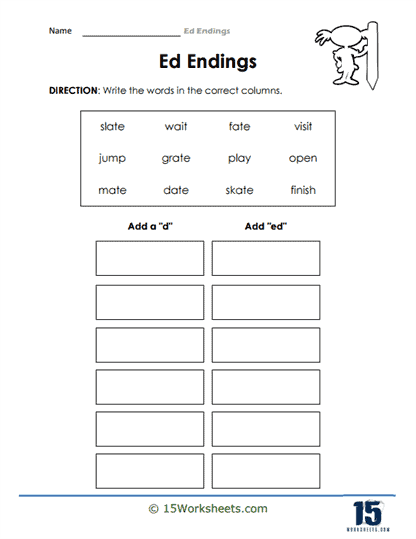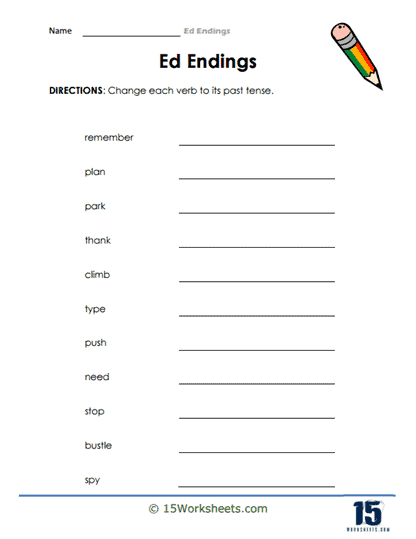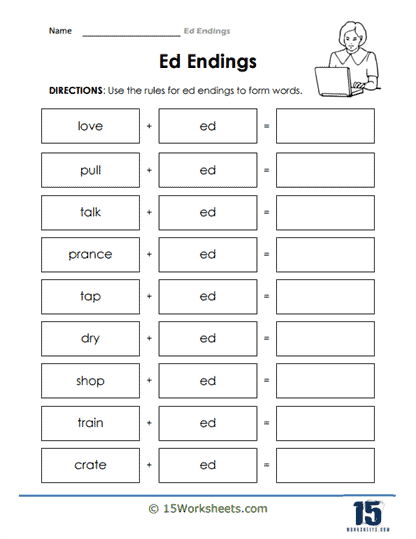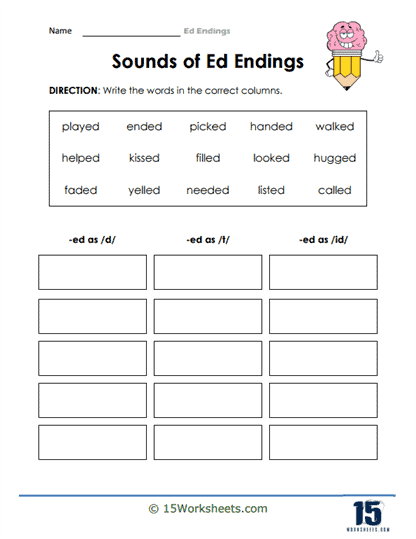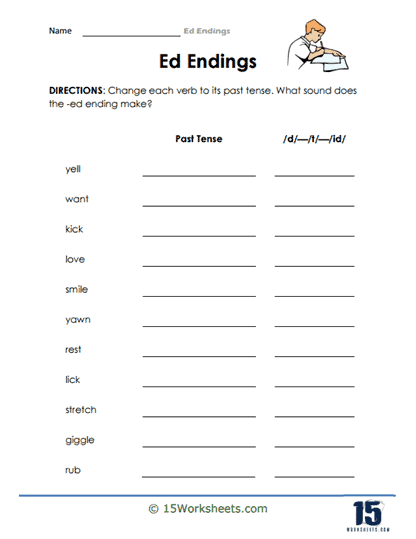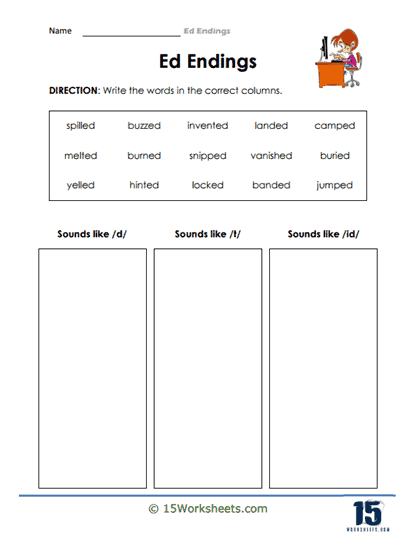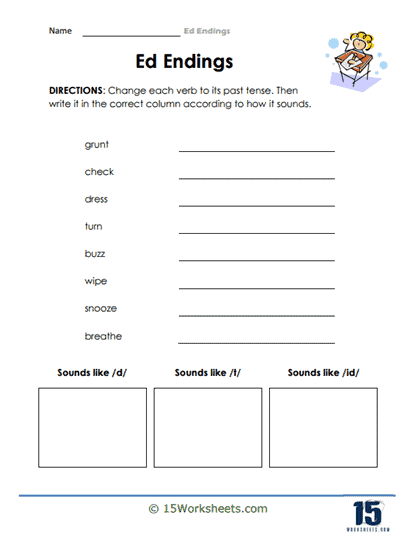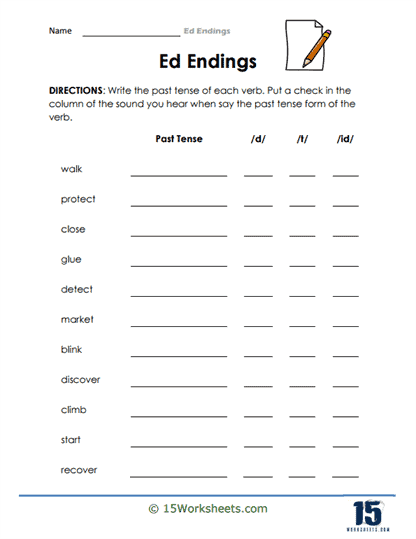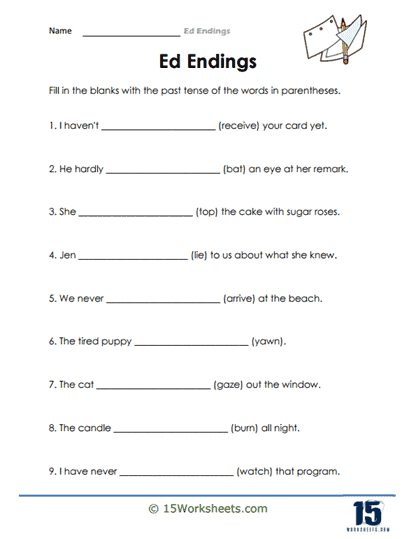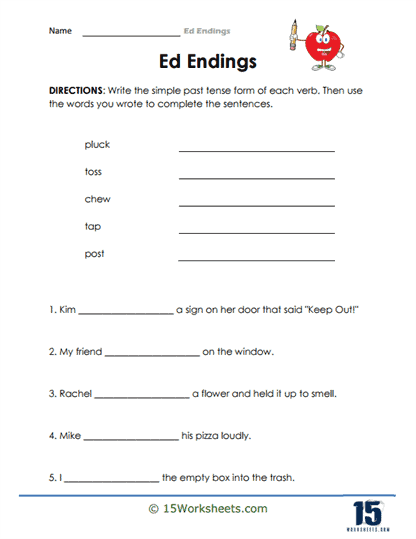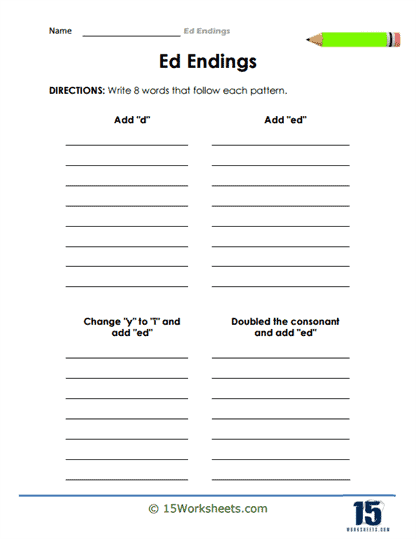Ed Endings Worksheets
All About These 15 Worksheets
These Ed Endings worksheets are designed to help students understand and practice the use of regular past tense verbs in English. Regular past tense verbs are formed by adding “-ed” to the base form of a verb and are used to describe actions or events that happened in the past.
These worksheets include a variety of exercises to help students identify and use regular past tense verbs correctly. Some examples of these exercises include:
- Sentence completion exercises – Students complete sentences by adding the correct past tense “-ed” verb.
- Verb conjugation exercises – Students conjugate regular verbs in the past tense.
- Sorting exercises – Students sort verbs in the past tense according to the rules they follow when conjugated.
In addition to these exercises, the first worksheet in this collection also includes explanations and examples of regular “-ed” verbs and irregular verbs that do not follow the “-ed” pattern.
Through these worksheets, students will:
- Master conjugating verbs into the past tense according to different rules in English grammar;
- Learn the correct pronunciation for verbs in past tense that follow the “-ed” pattern;
- And complete sentences by supplying them with the correct form of verbs in past tense.
Overall, these worksheets on the past tense “-ed” provide students with an opportunity to practice and reinforce their understanding of regular past tense verbs in English. By using these worksheets, learners can improve their ability to communicate more accurately and effectively in English, and become more confident and proficient in their language skills.
How do you transform verbs into their past tense form?
Regular verbs are the verbs that end in “-ed” in their past tense form. To transform regular verbs into their past tense form, simply add “-ed” to the base form of the verb. For example:
- Base form: talk / Past tense: talked
- Base form: watch / Past tense: watched
- Base form: jump / Past tense: jumped
However, there are some spelling and pronunciation rules to follow when adding “-ed” to the base form of a verb. Here are some common rules to follow:
- If the base verb ends in a vowel plus “y,” simply add “-ed.”
- Base form: play / Past tense: played
- If the base verb ends in a consonant plus “y,” change the “y” to “i” before adding “-ed.”
- Base form: try / Past tense: tried
- If the base verb ends in a single consonant preceded by a single vowel, double the final consonant before adding “-ed.”
- Base form: stop / Past tense: stopped
- If the base verb ends in “-e,” simply add “-d.”
- Base form: like / Past tense: liked
- For most other verbs, simply add “-ed.”
- Base form: work / Past tense: worked
It’s important to note that irregular verbs do not follow the “-ed” pattern, and their past tense forms must be memorized. For example, the base form of the verb “go” is irregular, and its past tense form is “went”.
How do you pronounce different verbs with “-ed” endings?
Regular past tense verbs in English can be pronounced in three different ways, depending on the final sound of the base form of the verb. These three different pronunciations are often referred to as “-ed” sounds and are commonly classified as “d” sounds, “t” sounds, and “id” sounds.
- “D” sounds: When the base form of a verb ends in a voiced consonant sound (e.g. b, g, l, m, n, v, z), the “-ed” ending is pronounced as a “d” sound. Examples of verbs with a “d” sound include:
- Base form: played / Past tense: played
- Base form: begged / Past tense: begged
- Base form: traveled / Past tense: traveled
- “T” sounds: When the base form of a verb ends in an unvoiced consonant sound (e.g. k, p, s, sh, ch, f), the “-ed” ending is pronounced as a “t” sound. Examples of verbs with a “t” sound include:
- Base form: talked / Past tense: talked
- Base form: stopped / Past tense: stopped
- Base form: missed / Past tense: missed
- “Id” sounds: When the base form of a verb ends in the sound of “t” or “d,” the “-ed” ending is pronounced as an “id” sound. Examples of verbs with an “id” sound include:
- Base form: wanted / Past tense: wanted
- Base form: ended / Past tense: ended
- Base form: needed / Past tense: needed
It’s important to note that while these three pronunciation patterns are common for regular past tense verbs, there are some exceptions and irregular verbs that do not follow these patterns. Understanding the correct pronunciation of past tense verbs is an important part of English grammar and can help students communicate more accurately and effectively.





